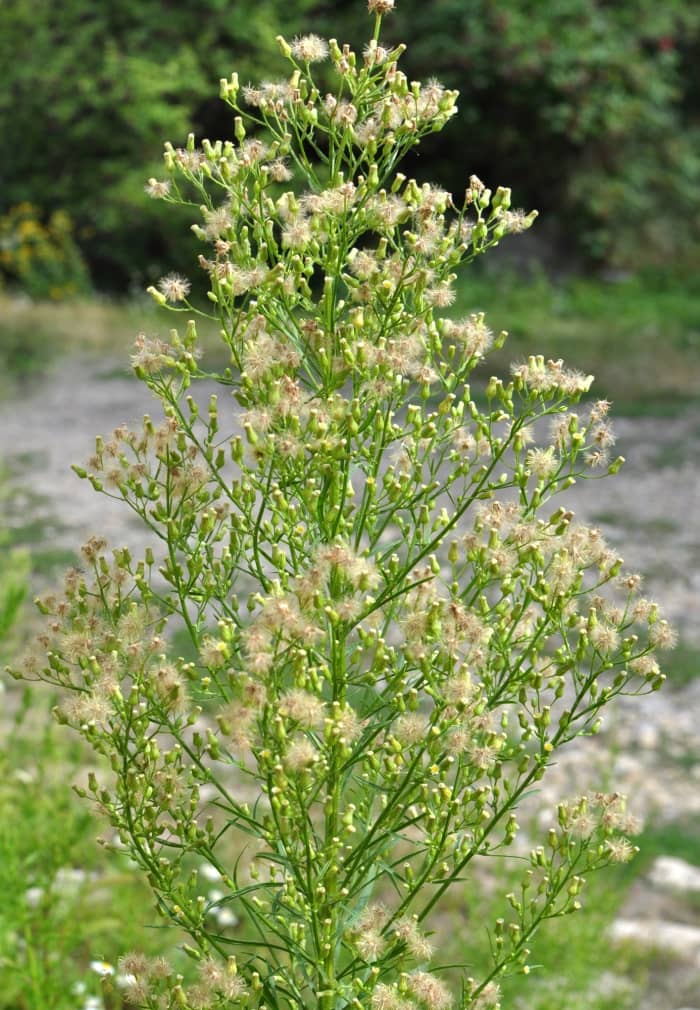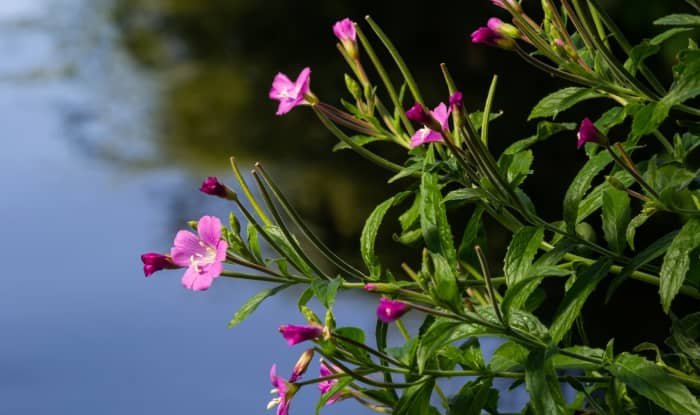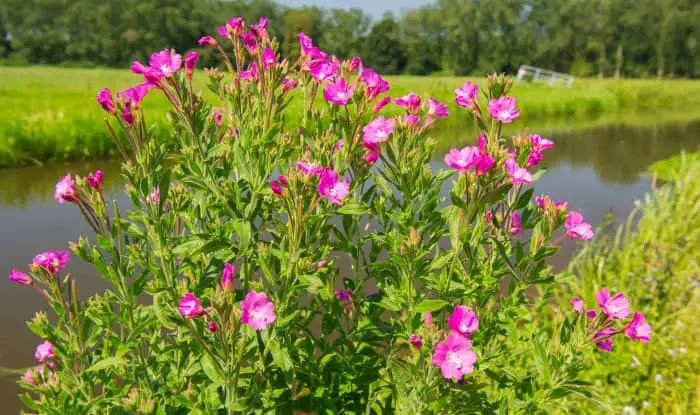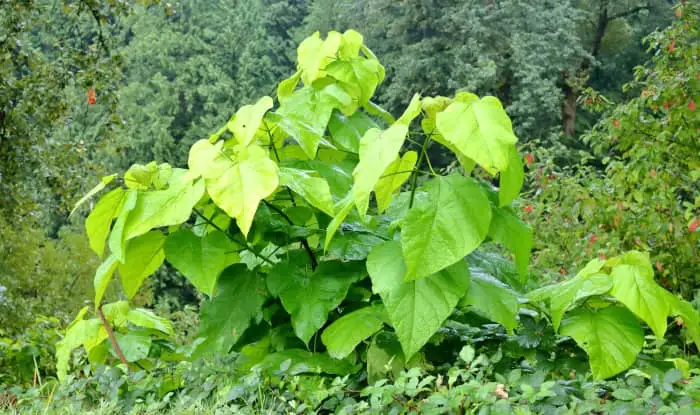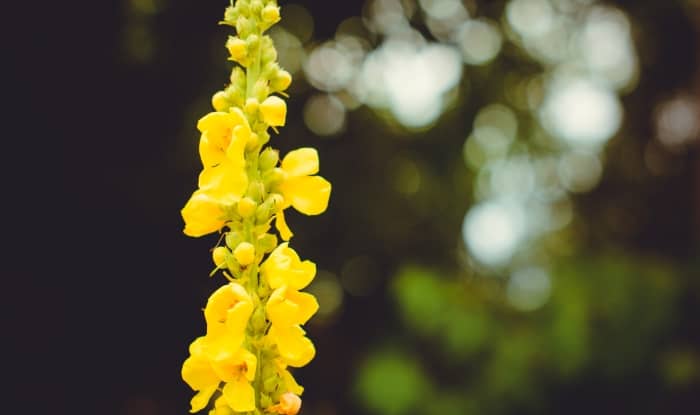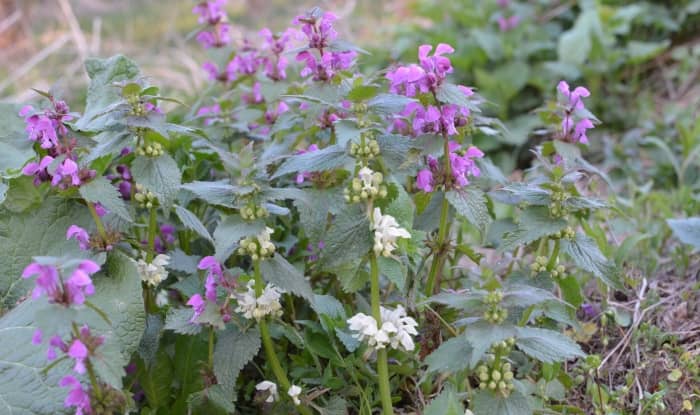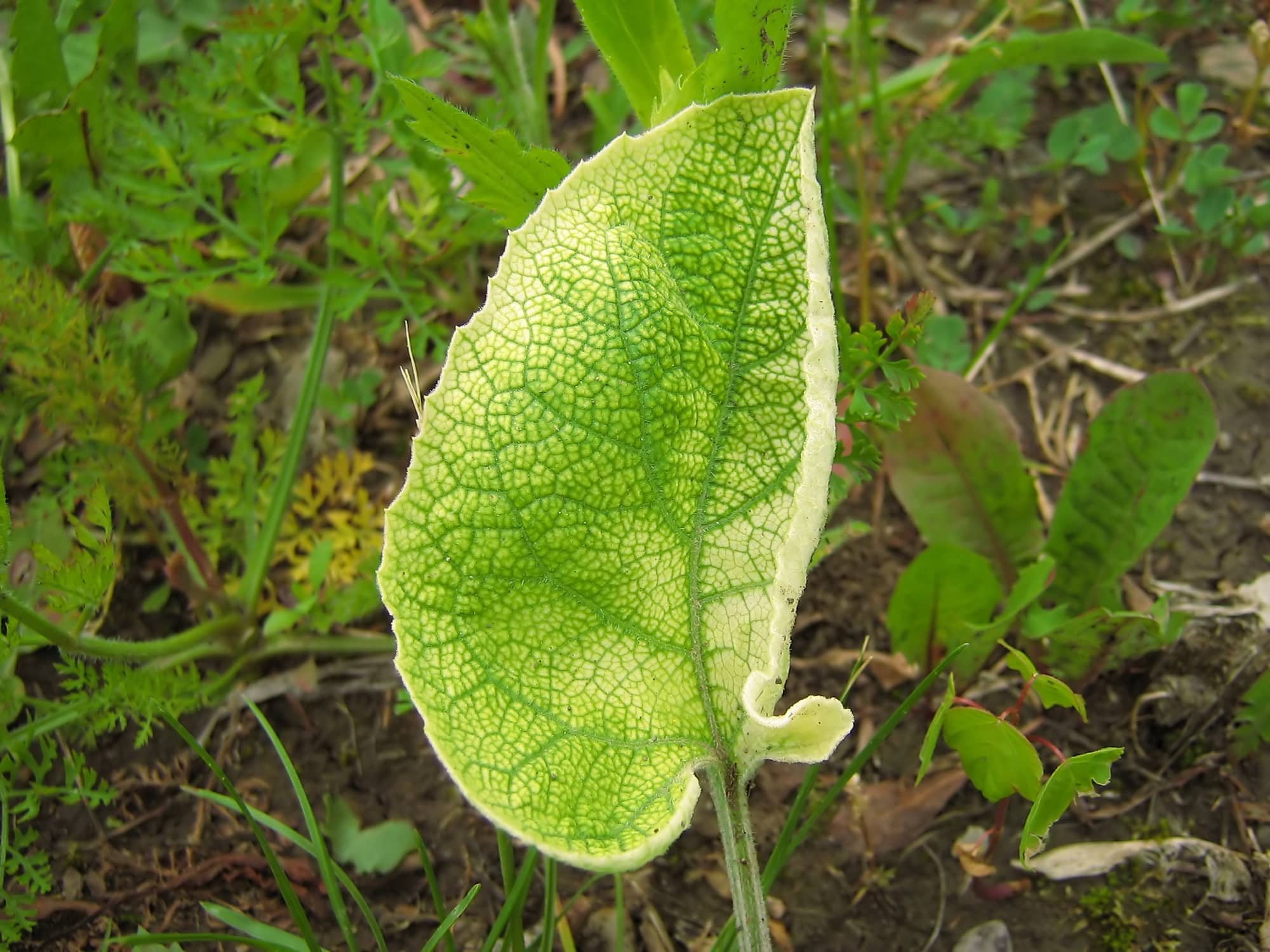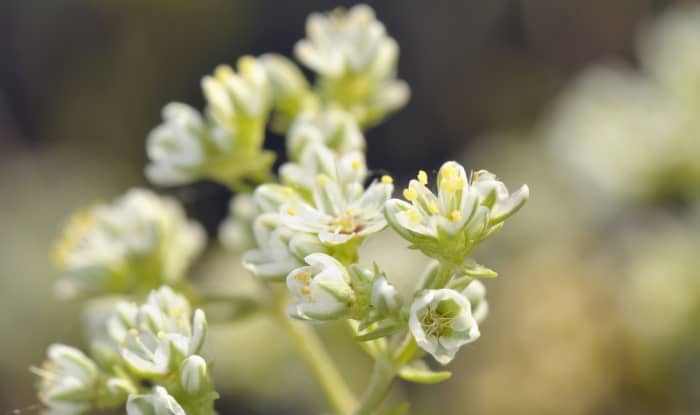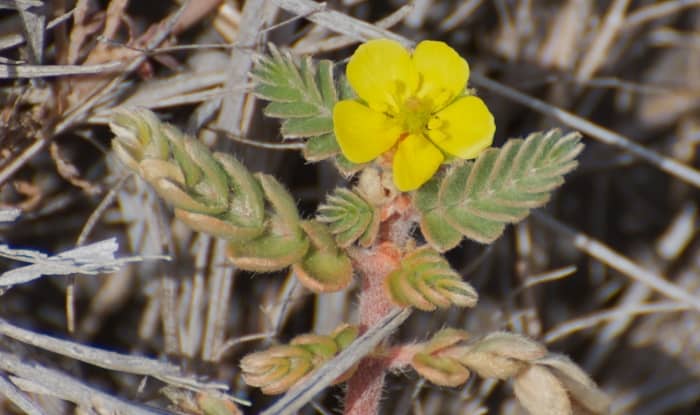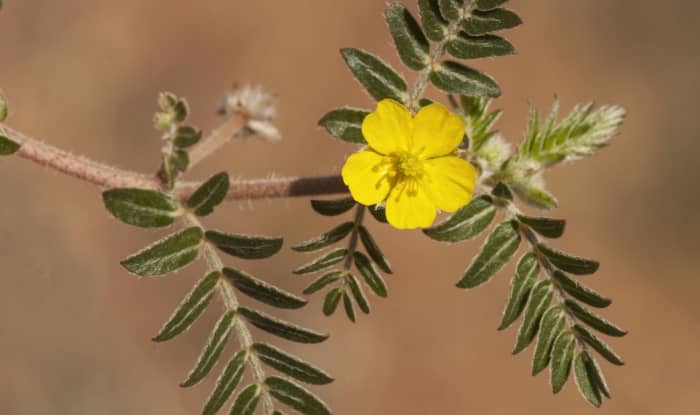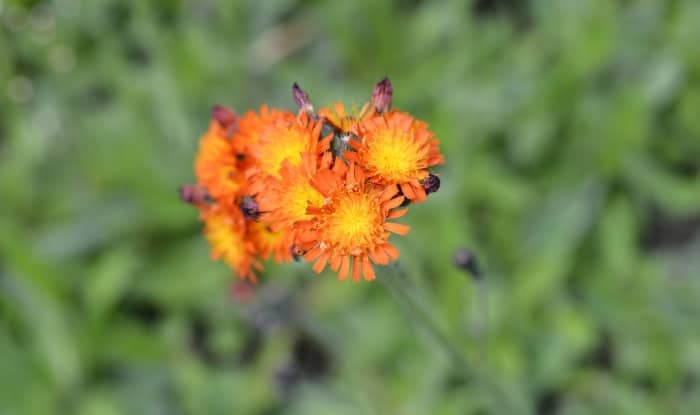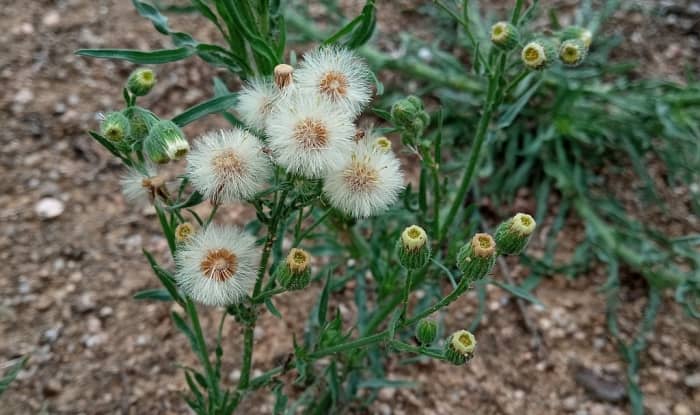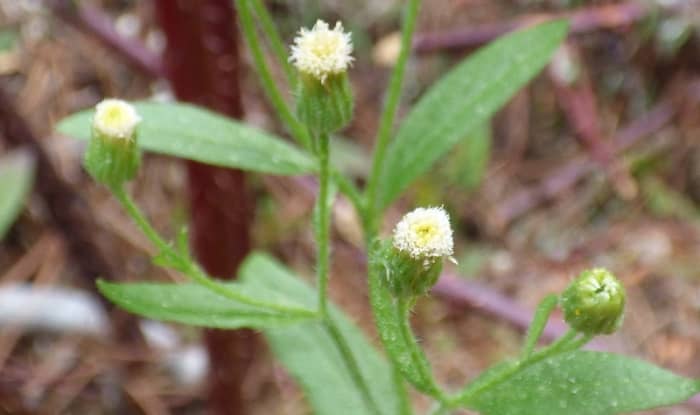Have you found some weeds with hairy leaves in your garden?
I’ll help you identify them with photographs and detailed descriptions.
Let’s dive in.
Weeds With Hairy Leaves
Here are some of the most common types of weeds with hairy leaves:
Horseweed (Erigeron canadensis)
Also called mare’s tail, horseweed is a summer annual that’s a common landscape and agricultural weed. It’s a tall weed with hairy leaves that develops a single hairy stem that can reach 6-10 ft. in height.
The long, narrow leaves grow alternately from the stem without a petiole and are irregularly toothed.
At the very top of the weed the stem branches and produces small, white daisy-like flowers when in bloom. The flowers give way to tiny seedheads from late July to October, similar to those found on dandelions, that are dispersed by the wind. Each plant can produce up to 200,000 seeds.
Hairy Galinsoga (Galinsoga quadriradiata)
Also known as shaggy soldier or quickweed, hairy galinsoga is a weed with hairy leaves that causes problems for gardeners when it becomes established. The weed often invades vegetable gardens, growing in dense patches that crowd out other plants.
Hairy galinsoga is a summer annual weed that grows between 5-30 inches tall. The erect, branched stems are hairy, as are the leaf margins. The leaves grow opposite and are toothed.
From mid-June to late fall the weed blooms producing flowers with a densely packed yellow disc floret and 5 white ray florets.
The weed is difficult to control because it produces many seeds that can germinate immediately upon falling to the ground, allowing the plant to produce between 3-5 generations in a growing season.
Hairy Willowherb (Epilobium hirsutum)
Hairy willowherb is an attractive pant that’s sometimes grown as an ornamental. But when it escapes cultivation it can spread aggressively and can be difficult to get rid of. It’s now considered an invasive and noxious weed in some states.
Hairy willowherb grows to around 6 ft. tall with erect branched stems and lance-shaped, toothed leaves that grow opposite each other clasped to the stem. The stems and leaves are covered with soft hairs.
From July to August the plant blooms, producing pink purple-flowers with notched edges and white centers.
The weed spreads through thick rhizomes and seeds that develop in long narrow seedpods. The seeds have long white hairs and float on the wind to new locations.
Hairy willowherb is often found in wetlands in the same areas as purple loosestrife and grows in dense stands that crowd out native plants.
Velvetleaf (Abutilon theophrasti)
Growing up to 8 feet, velvetleaf is a tall weed with large, hairy leaves, that are soft to touch and give the weed its descriptive name (1).
In the summer, the plant produces 5-petalled, orange-yellow flowers that grow up to 1-Inch in diameter from the leaf axils on short stalks.
You’ll find velvetleaf growing in gardens and agricultural fields. But it’s also common to find this weed growing beside railroad tracks and roadsides.
In a number of states, velvetleaf is considered a noxious weed. It’s a very competitive plant that takes nutrients and water out of the soil, preventing crops from getting sufficient quantities and reducing their yield.
And it can be difficult to get rid of. The seeds stay dormant in the soil for a long time. They’re brought to the surface when land is disturbed and sprout when the soil becomes warm enough in the spring.
Check out our guide for more weeds with velvety textured leaves.
Common Mullein (Verbascum thapsus)
Also called great mullein and woolly mullein, common mullein is a giant weed that grows over 7 ft. tall. The common mullein plant has grey-green leaves that are thick and oval-shaped. A fuzzy covering of woolly hairs gives the weed’s big leaves a velvety texture. The leaves grow from 4-12 inches long and 1-5 inches wide.
Common mullein is a biennial weed. In the first year, the plant grows a basal rosette of furry leaves. And in the second year, the weed develops a tall stem. Common mullein flowers from June to September. With small yellow flowers clustering in a large spike at the top of the stem.
Originally native to Europe, Asia, and North Africa, great mullein is an invasive weed in many areas of North America and Australia.
Purple Deadnettle (Lamium purpureum)
Purple deadnettle is a winter annual broadleaf weed that you’ll often find in moist areas such as drainage ditches, the edges of woodland, or shady lawn areas with poor drainage.
Purple deadnettle is an aggressive grower, and in the right conditions, the weed quickly spreads.
Purple deadnettle has distinctive square, reddish-green stems. At the top of the stems are small pink-purple flowers. If you look closely, you’ll see that the weed has leaves that are heart-shaped or triangular with gently scalloped edges. The fuzzy leaves are covered with fine hairs.
Purple deadnettle is usually a low-growing plant, although sometimes it grows up to 10-inches tall.
To help you identify other weeds with heart-shaped leaves check out our guide.
Common Burdock (Arctium minus)
Also known as lesser burdock, common burdock is a biannual weed. It’s a common weed to find growing in your backyard and on your lawn. You also find it in pastures, paddocks, next to roadsides, and alongside streams.
Identifying burdock is simple. During the first year of growth, the weed develops a basal rosette. Burdock is a weed that grows huge leaves that reach 6-18 inches long and 4-14 inches wide. The leaves are dark green, heart-shaped, and have fine hairs on the underside (2). The broad leaves have reddish stems that make them resemble rhubarb leaves.
In the second year of growth, burdock sends up a tall hollow stalk that can reach 6 feet high with alternate growing leaves that are smaller than the basal leaves. The plant blooms from July to October, producing lavender to purple flowers at the end of branches and in the leaf axils.
The flower heads resemble a thistle and are covered in spines. Each flower head dries up as they age. And turn into prickly burrs with curved spines. The burrs easily hook onto clothing or the fur of animals to spread the seed they contain.
Once common burdock is established in your yard it’s difficult to get rid of the weed because of its deep taproot and the large volume of seeds each plant produces. The plant only reproduces by seed, so try to prevent it from doing so by cutting.
Unlike many weeds, common burdock has some uses. The leaves, stalks, and roots are all edible, and you can use them for medicinal purposes.
Hairy Bittercress (Cardamine hirsuta)
Hairy bittercress is an annual weed that emerges in early spring, usually about February. You can identify this weed by its scalloped leaves arranged alternately around a central stem, and its little white flowers. The stem and leaves have small hairs that are most noticeable on young plants.
Hairy bittercress thrives in wet soil and it’s common to notice its growth after you’ve had a period of heavy rainfall.
It’s a good idea to eradicate hairy bittercress from your lawn before the small white flowers produce seedpods. The seeds spread easily over quite a long distance. And it doesn’t take many plants to create an infestation the following spring.
Hairy bittercress has compound leaves that consist of multiple small leaflets growing along a leaf stalk with a single leaflet at the tip. The leaves grow to about 6-inches long
The flowers have four white petals arranged in a cross that eventually fall off leaving behind a green seed pod.
Hogwort (Croton capitatus)
Hogwort is also known as Texas goatweed and wooly croton. The plant is native to central and eastern USA but is considered a noxious weed throughout the midwest.
The weed grows between 1-2 ft. tall and has branched stems covered with wooly hairs that can be either rusty brown or white. The weed leaves have a covering of hairs and have a velvety feel when touched. The leaves are egg-shaped or lanceolate, grow alternately from the stems, and sometimes have wavy margins. Because of all the woolly hairs that cover the plant, the weed has a whitish appearance.
Hogwort blooms from June to October, producing small white flowers that grow at the end of the stems, densely clustered around the tip.
You’ll often see hogwort growing in fields, prairies, pastures, and roadsides. It can cause problems in pastures as the weed is poisonous to horses and cattle if it gets mixed into hay. But usually, the animals avoid it and a pasture with a lot of hogwort growing in it is likely overgrazed.
Carolina Horsenettle (Solanum carolinense)
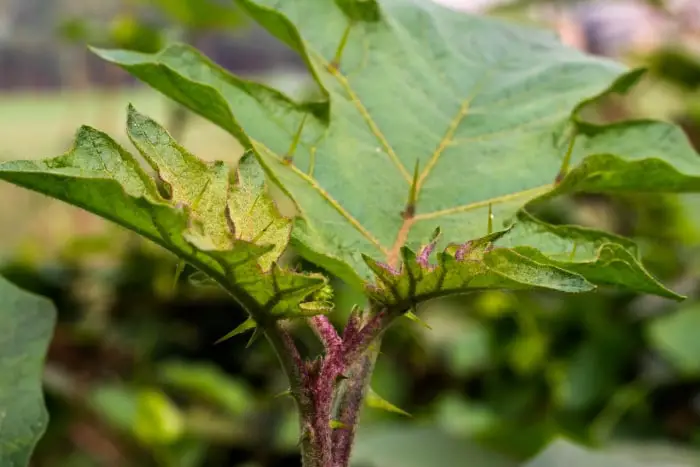
Also called devil’s tomato, horsenettle is part of the nightshade family. The weed produces fruit that resemble small tomatoes (2). But be warned, horsenettle is one of the worst weeds to find in your garden. It’s a poisonous weed and the fruit is toxic to eat. Just handling the plant causes a rash for some people.
Horsenettle emerges in the spring, and when fully grown, it reaches 3 ft. tall. Horsenettle weeds develop large thorns on the leaves and stems as the plant grows. The leaves are covered in hairs and have lobed margins. And they’re arranged alternately on the stems.
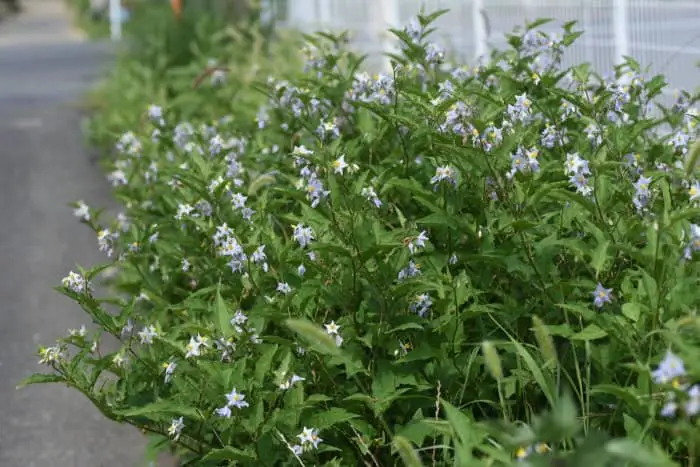
Horsenettle produces clusters of star-shaped flowers from May to October. Each flower consists of 5 white to pale-violet petals, with yellow anthers at the center.
It’s probably easiest to identify horsenettle by the tomato-like berries it produces. The berries are round and about ½-inch in diameter. And turn from green to yellow as they mature.
Goat Head Weed (Tribulus terrestris)
Goat head weed is also called devil’s thorn, puncturevine, and bindii. It’s notorious for the sharp barbs on its fruit. These vertical spikes resemble horns and easily puncture thin shoes, bare feet, bicycle tires, and the hooves of animals. This allows the seeds to be carried to new locations. And so the plant spreads.
Goat head weed is a creeping weed that grows low to the ground. With long hairy stems that grow up to 5 ft. long, forming a dense mat as they spread out from a central taproot. This is a weed with hairy leaves that consist of 4-8 pairs of opposite growing leaflets (3).
Goat head weed is a fast-growing noxious weed. It germinates in the spring and starts flowering within 3 weeks. Producing yellow flowers from April through to October. After the flowers bloom, the weed produces the small spiky fruit.
You can control goat head weed by hand pulling or using a hoe to cut the weed away from the taproot. It’s best to deal with goat head weed before it flowers and produces seeds.
Orange Hawkweed (Hieracium aurantiacum, Pilosella aurantiaca)
Orange hawkweed is also known as devil’s paintbrush, flameweed, and devil’s weed. It’s a native plant to Europe and an introduced species in North America.
Although sometimes sold in nurseries as an ornamental plant, orange hawkweed is also considered a noxious weed in many areas.
You’ll often find orange hawkweed growing in pastures, meadows, and sometimes as an annoying weed on your lawn, where it aggressively outcompetes and crowds out native plants with its dense growth.
Orange hawkweed has tall flowering stems that usually grow up to 24-inches. At the top of the stems are clusters of red-orange flowerheads. The flowerheads have an orange center with red at the edges and grow to about 1-inch in diameter.
Shortly after they start to flower, each plant sends out white-fuzzy stolons that creep along the ground up to 12-inches helping the weed to spread. Orange hawkweed also spreads by seeds and rhizomes.
PILOSELLA AURANTIACA BY JOOST J. BAKER IJMUIDEN
The hairy leaves are mostly in a basal rosette and are lanceolate, with fuzzy hairs on both sides. You might see 1 or 2 stem leaves.
You’ll usually find this weed growing in sunny locations, although it can sometimes grow in partial shade. It’s common to find orange hawkweed in meadows, pastures, forest areas, and along roadsides.
Hairy Fleabane (Conyza bonariensis, Erigeron bonariensis)
ERIGERON BONARIENSIS BY JOSEP GESTI, CC BY 4.0 VIA WIKIMEDIA COMMONS
Hairy fleabane is a summer annual or biennial weed in the daisy family known for its rapid growth and aggressive spread. The weed can be very hard to control, spreading through a high volume of wind-dispersed seeds.
Hairy fleabane grows up to 4 ft. tall and has alternate gray-green leaves growing from branched stems. Long, soft hairs and short, rigid hairs cover the leaves, giving the weed leaves a fuzzy feel. The leaves towards the base of the plant are usually egg-shaped with a short leaf stalk. The leaves higher up the stems are linear to lance-shaped.
HAIRY FLEABANE FLOWERS BY FOREST AND KIM STARR
The plant blooms from June to September, producing numerous flowering stalks at the end of the stems. The small, yellow disk flowers are encased by cream-colored bristles and sit in a green cup-shaped base. The flowers are replaced by seed puffs that resemble dandelion puffballs.
The weed is sometimes confused with horseweed, but you can distinguish them by the narrower, more crinkled leaves of hairy fleabane.
You’ll often come across hairy fleabane in disturbed sites in urban areas, cultivated fields, and along roadsides. The weed can spread into garden areas and grows between cracks in pavement stones and driveways.
Reference:
- Velvetleaf, Abutilon theophrasti – https://hort.extension.wisc.edu/articles/velvetleaf-abutilon-theophrasti/
- Horse Nettle – https://mdc.mo.gov/discover-nature/field-guide/horse-nettle
- Goathead – https://nazinvasiveplants.org/goathead


